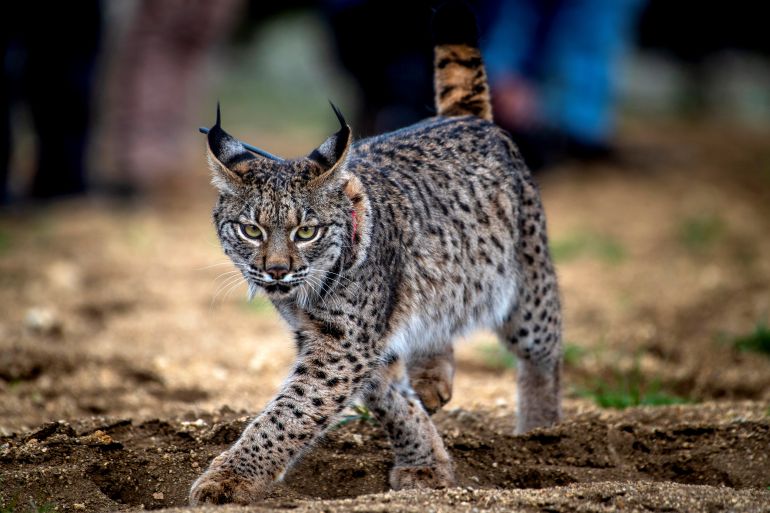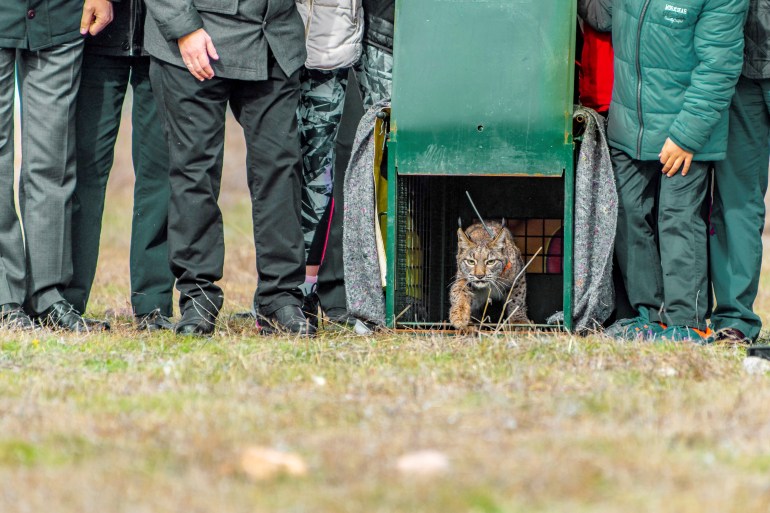Breeding project boosts Iberian lynx numbers from 94 to 1,100
Saving the endangered feline in Spain and Portugal has been a European effort over the past 20 years, costing tens of millions of dollars.

Villanueva del Rio y Minas, Spain – When the hatch was pulled up on the box, Secreto blinked in the sunlight for a moment before he bounded off to freedom.
Moments later, Sirena followed, but she did not hesitate to dash off to a new life of liberty in the countryside.
Keep reading
list of 3 itemsThai construction tycoon jailed for poaching protected animals
Rush to save animals in Indonesia after deadly Mt Semeru eruption
In a remote private estate in the countryside near Seville in southern Spain, this was a rare chance to witness two Iberian lynx being released from captivity into the wild.
At the sight of the animals’ pointy, tufty ears and distinctive dotted coats, a cheer went up among the select group who watched Secreto and Sirena embrace the wild.
The male and female will, it is hoped, help propagate the growing species of Iberian lynx which has recovered from near extinction.
More than 40 years ago, there were estimated to be about 1,100 lynx in southern Spain and neighbouring Portugal.
Near extinction
However, by 2002, this figure had fallen drastically to just 94 because of hunting by humans, the destruction of its natural habit and a succession of illnesses among its favourite food source – the rabbit.
This rare cat was classified as “critically endangered” and faced sharing the same fate as the sabre-toothed tiger, which became extinct about 11,700 years ago.
Twenty years on, after an ambitious breeding programme, the latest census of lynx numbers in 2020 showed its numbers have reached 1,100 again.
The feline has made a remarkable recovery, but it is not safe yet. It is still classed as “endangered”, according to the International Union for Conservation of Nature.
One factor that helped save the lynx has been a plentiful stock of more than 100,000 rabbits, which were introduced to the main lynx breeding grounds between 2002 and 2020 at a cost of more than one million euros ($1.1m).

As we waited to see these rare cats, it was not hard to guess why the Arenillas estate, about an hour’s drive north of Seville, might have been chosen – rabbits were hopping around everywhere.
In fact, the veterinarians behind Life LynxConnect, the feline’s restoration project, carefully chose this spot.
When they are one year old, the lynxes are released into areas where there is already a known population of the feline.
Like proud parents, those involved in the project follow the animals’ lives in the wild via GPS tags.
Javier Salcedo, the leader of the five-year Life LynxConnect, said the objective was to raise the population so it can be classified as “vulnerable” instead of “endangered”.
There are four breeding centres, three in southern Spain and one in neighbouring Portugal.
“The purpose of the project is to connect different nuclei of lynxes to vary the species and so that they are not isolated,” he told Al Jazeera.
Salcedo, who has led the project for two years, said “it gives me enormous satisfaction that this has been a success”.
Tens of millions in budget
Saving the lynx has been a European effort for 20 years.
The European Commission contributes 60 percent of the 18.7 million-euro ($20.8m) budget for Life LynxConnect from 2020 to 2025 while the rest of the budget comes from the Spanish and Portuguese governments, regional authorities, private companies and charitable foundations like the World Wildlife Foundation.
Pouring cash in to save an endangered animal and hoping for the best does not explain the project’s success.
The public relations battle to win over landowners, hunters and the general public has been crucial to saving the photogenic feline.
Each year, organisers name the animals after a letter of the alphabet. This year is S.
Local schoolchildren chose Secreto and Sirena’s names and when lynxes are released children are normally invited to watch the animals disappear into the undergrowth.
This time, the lynxes bore special importance for eight-year-old Marina Espila Zorrila.
She suffered from leukaemia and had been encouraged to adopt Secreto and Sirena to help in her struggle through gruelling chemotherapy.
“It was her prize to come along today to open the hatch and let them out if she got better. The lynx have really encouraged her,” her aunt Irene Zorrila Delgado, who works in a wild animal centre in Malaga in southern Spain, told Al Jazeera.
“We have shown her pictures of the lynx all through their lives. It has helped give her strength.”
Marina, who has made a full recovery from the cancer, smiled and said: “They were lovely.”
Protecting the ecosystem
Fatima Ramirez, the owner of the Finca Arenillas estate where the lynx were released, said the felines were good for the environment.
“We are very pro-lynxes. We have had an invasion of foxes and if nothing is done, other species will disappear. Lynxes are good because they kill any competition for their own food sources. This compensates the ecosystem,” she told Al Jazeera.
A law introduced by the Spanish dictator General Francisco Franco in the 1950s classed the lynx as vermin and decades of hunting were only stopped in the late 1970s when a ban was introduced.
The rabbit population was decimated in the 1990s by myxomatosis and a haemorrhagic disease.
Today, the main threat to the lynx is being run over by traffic or hunting, which is making a return as the population of these protected felines rises.
Secret lynx hunts have become an increasing problem, said Jorge Barciela, a veterinarian who analyses how lynxes are killed.
“They are seen as big trophies. The fines are very high. We can close down the estates where this is happening but it is very difficult to know who is doing this,” he said.
Destruction of habitat
Barciela said the Iberian lynx was pushed to the point of extinction through progressive road building in the countryside, forestry programmes that destroyed the lynx’s natural habit, hunting, and a succession of diseases that depleted the rabbit population.
His colleague Guillermo López, also a veterinarian, said that despite the lynx’s endearing appearance, the public relations battle is not over yet.
“Has Spanish society been won over to support what we are doing? It depends where you come from. If you come from the city, then yes, but if you are from the country, no,” he told Al Jazeera.
“Some farmers and poachers are against it. But internationally, we are doing well.”